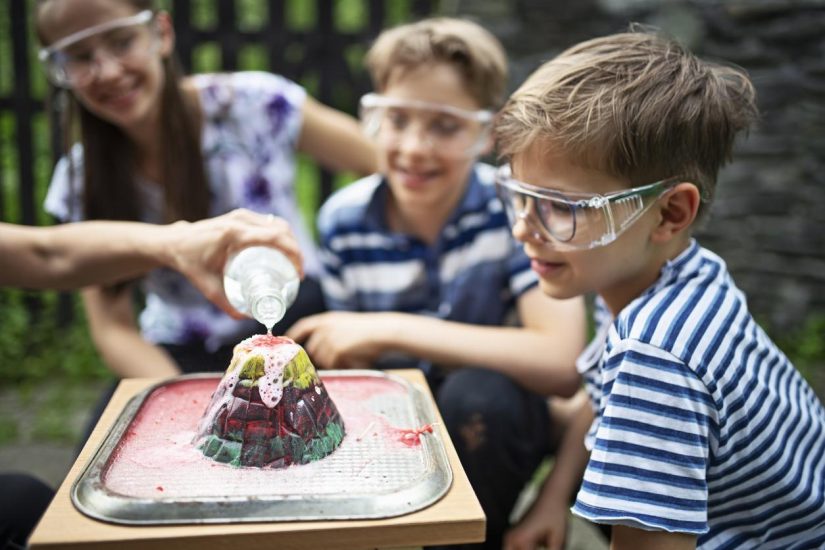Outdoor science experiments are an ideal way to help students develop curiosity and spark a love of learning. Being outdoors is highly stimulating for children, and engaging in hands-on STEM activities allows students to understand more deeply the relevance of science to everyday life.
Creating a mud volcano is a simple activity that combines creativity, tactile learning, and outdoor play in a way that’s both fun and educational. The eruption happens due to a chemical reaction between the baking soda (a base) and vinegar (an acid). When these two substances mix, they create carbon dioxide gas. This gas forms bubbles, which cause the fizzing and bubbling action that looks like a volcanic eruption.
Through this experiment kids will learn about basic chemistry, earth science, and even a bit of geology as they discuss how real volcanoes work
Follow these steps for some explosive and fun learning!
What You’ll Need
Before you begin, gather these materials:
- Mud: You can make mud by mixing dirt and water. The consistency should be thick enough to mold but not too watery.
- Baking soda: This will be the key ingredient for your volcanic eruption.
- Vinegar: This will react with the baking soda to create the “lava.”
- A small container or bottle: This will act as the core of your volcano.
- A tray or a clear outdoor space: To keep the mess contained.
- Optional: food colouring or dish soap: To add a splash of colour and make the lava foamier.
Step-by-Step Instructions
- Build the Volcano: Start by placing your small container or bottle in the centre of your tray or chosen outdoor spot. This container will hold the ingredients that will cause the eruption.
- Create the Volcano Shape: Surround the container with mud, shaping it into a mountain. Make sure the container’s opening is at the top, like the crater of a real volcano. This part is where kids can get creative! Encourage them to make the sides of the volcano look realistic with bumps and ridges.
- Prepare for the Eruption: Pour a few tablespoons of baking soda into the container inside the volcano. If you want to add colour to your eruption, mix some food colouring with the baking soda. You can also add a squirt of dish soap to make the eruption foamy.
- Erupt the Volcano: When you’re ready for the big moment, pour vinegar into the container. Watch as the mixture fizzes and bubbles, overflowing down the sides of your mud volcano, just like real lava!
Tips for a Successful Experiment
- Dress for Mess: This activity can get messy, so make sure kids are wearing old clothes that can get dirty.
- Supervise the Experiment: While the materials used are safe, it’s always a good idea to supervise young children during the experiment and to provide safety glasses.
- Extend the Learning: After the experiment, you can discuss how real volcanoes form and erupt. You might even want to look up videos or pictures of real volcanic eruptions to compare with your mud volcano.
How Tutor Doctor Can Help Students Engage with Science
While a tutor might not be able to conduct fun outdoors science experiments with students, there are many things they can do to ensure that science subjects are enjoyable and engaging.
Many students find science difficult because they are required to retain large amounts of information. Our tutors will assess your student to confirm their understanding of basic scientific principles and identify any gaps in knowledge. Based on this information, they will build a personalised learning program that is engaging and stimulating.
At Tutor Doctor we take great care to match students with a tutor suited to their needs and personality, and our learning plans are designed around students interests and specific requirements.
Contact us for a free consultation today.




